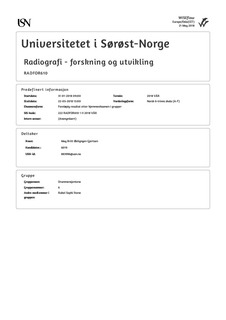Sammenligning av to metoder for klassifisering av slitasje ved personlig verneutstyr
Bachelor thesis
Permanent lenke
http://hdl.handle.net/11250/2593668Utgivelsesdato
2018Metadata
Vis full innførselSamlinger
Sammendrag
Background and purpose: The Norwegian Radiation Protection Authority was in2014 with revised recommendations for quality control of personal protective equipment (PPE). Various types of PPE are important appliances for radiation protection for occupationally exposed. The purpose of this study has been to survey whether the revised recommendations are optimal in terms of classification of wear and tear and consistent with important radiation protection principles to ensure optimal protection. The problem is: To what extent are scratches and holes in PPE at visual and palpation inspection (V/P) identified as efficiently as fluoroscopy? Method: The study is conducted as an empirical observation study with quantitative data. Today's quality assurance system, V/P, is compared to previously used system, fluoroscopy. Data collection is performed following the quality control procedures for the two quality assurance systems of all available PPE at an image diagnostic section. The results are compared using tables and figures. Results: Quality control was carried out on 103 PPE divided into three modalities. Different classification was observed using the different systems. The number of discards increased by 5 PPE after fluoroscopy. 5 discarded PPE had the same purchase year. Conclusion: The study revealed more serious defects by fluoroscopy than at V/P. This may indicate that the revised recommendations are not good enough to detect serious damage to PPE. Permanent implementation of fluoroscopy is considered ppropriate to detect findings and increase optimal radiation protection effect.
